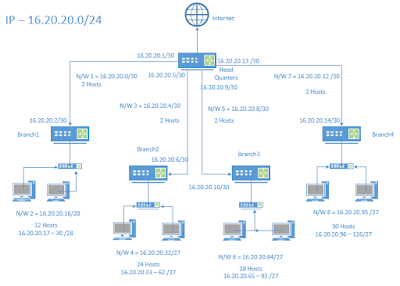Easy way to do SUBNETTING
Example:
If you want to design your network and connect HQ and Branches using one IP block, so we need subnetting.
Below diagram will help in understanding Subnetting.
IP address has NETWORK side and HOST side **IP addressing.
**SUBNET MASK always says bit on network side.
So, Subnetting can be done by 2 ways:
- Host Side subnetting
- Network Side subnetting
I. HOST SIDE SUBNETTING:
If we want to design host point of view, collect all the number of host in your network according to the branches and connectivity.
Branch1 = 12 Host;
Branch2 = 24 Host;
Branch3 = 28 Host;
Branch4 = 30 Host;
Connectivity = 2 Hosts;
Process:
- Identify which branch has more requirement (Branch4) because if you break network according to the branches, Branch4 will have shortage of IP's.
- Branch4 = 30 hosts
- Add 2 more hosts (30+2=32) because as you know a block of IP addresses contains a Network address and Broadcast address so it cannot be use as host address.
- Now match nearest 2^n to the value
- 2^5=32, n=5
- 'n' means number of bit on host side. 5 bits on host side.
- 32 means total number of host.
- IP address has total 32 bits and we have taken 5 bits for host side. So, 32-5=27, 27 bits on network side.
- 16.20.20.0/27
- We have successfully done subnetting from /24 to /27, 3 bits we have taken from the network side which will be used for our subnet blocks.
- Now you can use this blocks to each of your branches and connectivity, each block are in same subnet (can be switched).
- Remember First address is Network address (16.20.20.0) and Last address is Broadcast address (16.20.20.31) they cannot be use for hosts.
- If you want to use them use cmd:
- IP subnet-zero
- This method is Fixed Length Subnet Mask (FLSM).
- Disadvantage is many IP's will be wasted or unused in your network. We used VLSM - Variable Length Subnet Mask.
II. NETWORK SIDE SUBNETTING:
If we want to design network point of view subnetting, collect number of networks needed
Process:
- We need 8 n/w's. Don't need to add 2 more to the n/w as we did in host process.
- Nearest 2^n to the number of networks required; 8=2^3
- Where 'n' means number of bits to take from network side. 3 bits we have to take from network side.
- As per our example, 24 bits are there in network side so we have to take 3 bits more.
- 24+3=27 bits on network side
- Total bits are 32 bits in IP address
- 32-27=5, 5 bits on host side
- 2^5= 32 (Similarly to Host point of view); 32 number of hosts.
- We have successfully done subnetting.
III. VSLM:
Since, there are to many wasted or unused IP addressing in FLSM we use VSLM to overcome this disadvantage in FLSM.
- We need 2 hosts on all the connectivity between HQ and Branches, so we will apply Host point of view process and you will obtain,
- 16.20.20.0/30
- Do it from each links,
- 16.20.20.4/30; 16.20.20.8/30; 16.20.20.12/30
- Similarly, for each branches according to the host and add to the above block to continue your IP subnetting.
- Branch1 = 16.20.20.16/28
- Branch2 = 16.20.20.32/27
- Branch3 = 16.20.20.64/27
- Branch4 = 16.20.20.95/27
- So, if you notice we have saved lots of IP's that can be used if we want to extend the network (adding another branch office).
- Finally, Subnetting design for our example as follows:
★CT21
Reference: https://rstforum.net/ (CCNA training)







No comments:
Post a Comment